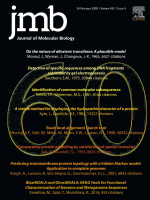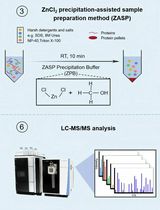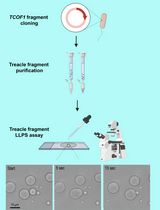- EN - English
- CN - 中文
Methods for the Extraction of Heme Prosthetic Groups from Hemoproteins
从血红素中提取血红素辅基的方法
(*contributed equally to this work) 发布: 2021年09月20日第11卷第18期 DOI: 10.21769/BioProtoc.4156 浏览次数: 4532
评审: Laxmi Narayan MishraAmit KumarAnonymous reviewer(s)
Abstract
Hemoproteins are widely researched because they contain redox-active heme prosthetic groups (iron + protoporphyrin IX) that enable them to perform a range of vital functions, acting as enzymes, participants in electron transfer reactions, or gas sensing, carrying, and storage proteins. While the heme prosthetic group is almost always essential for hemoprotein function, it is frequently desirable to remove it from the protein to enable biochemical or protein engineering studies. Obtaining high yields of the apo form of the hemoprotein can be challenging since high heme-protein binding affinities necessitate the use of harsh conditions to remove heme. In this Bio-Protocol, we present three chemical extraction methods that can be used to efficiently remove heme: methyl ethyl ketone extraction, acid-acetone precipitation, and on-column heme extraction. We also present protocols that can be used to quantitate the amount of residual heme bound to the protein after performing the extraction procedures.
Keywords: Hemoprotein (血蛋白)Background
Many proteins in biology contain heme prosthetic groups with redox properties that enable them to participate in a myriad of cellular processes (Huang and Groves, 2018). Hemoproteins have a range of functions, including among others, acting as enzymes that mediate cellular metabolism (e.g., oxidases, catalases, peroxidases), as participants in electron transfer reactions, and as oxygen sensing, carrying, and storage proteins (e.g., hemoglobin, myoglobin) (Poulos, 2014). Moreover, because heme contains the essential micronutrient iron, many microbial pathogens express hemoproteins that capture iron-laden heme from their hosts during infections (Runyen-Janecky, 2013; Choby and Skaar, 2016). There are four major types of heme (A, B, S, and O), which differ in their substituent pattern around the porphyrin ring. The most common type is heme B, which consists of protoporphyrin IX and a central iron atom (Reedy et al., 2008). Heme B, hereafter referred to simply as heme, is lipophilic and tightly bound by hemoproteins that donate axial ligands to coordinate the iron atom (Baker et al., 2003). It is often desirable to remove heme from a hemoprotein, as it enables study of the apo (heme-free)-protein and provides a route toward the introduction of non-native metalloporphyrins that confer novel spectroscopic or enzymatic properties to the resulting artificial metalloprotein (Fruk et al., 2009). However, removing heme effectively is quite challenging, as it can be tightly bound within the heme pocket of the protein, generally precluding its removal through simple dialysis approaches.
Several protocols have been reported to extract heme from a hemoprotein: (1) methyl ethyl ketone (MEK) extraction (Teale, 1959); (2) acid-acetone precipitation (Rossi-Fanelli et al., 1958); and (3) prosthetic group transfer to a high-affinity apo-hemoprotein (Chien et al., 2017). Acid-acetone precipitation was the first of these methods to be implemented and requires the use of acidified acetone to disrupt heme–protein interactions and precipitate the apo form of the protein. The protein is recovered by redissolving the precipitate in buffer or water, but the harsh conditions utilized in the reaction often result in loss of protein due to poor resolubilization of the apo-protein (Ascoli et al., 1981). In the MEK extraction method, the affinity between heme and the hemoprotein is also weakened by sample acidification. In this procedure, the apo-protein and free heme partition into distinct liquid phases, enabling their separation. MEK extraction is the most widely used of the chemical extraction methods (Sjodt et al., 2018; Ellis-Guardiola et al., 2020) and in our experience, results in more thorough heme-stripping and higher apo-protein recovery than acid-acetone precipitation. For some hemoproteins, MEK or acid-acetone chemical extraction of heme leads to low recovery yields of the apo-protein, presumably because the apo-protein aggregates or does not refold properly. To circumvent these problems, apo-myoglobin can be used to remove heme molecules from the hemoprotein (Muller-Eberhard et al., 1969; Chien et al., 2017). This method enables heme extraction without protein denaturation, but it can be cumbersome to use in practice because it often requires large quantities of the apo-myoglobin reagent, and additional procedures are needed to physically separate myoglobin from the apo-protein after heme has been removed. As an alternative to these methods, our lab has implemented an on-column heme removal protocol that allows for concomitant heme removal and protein purification by immobilized metal affinity chromatography (IMAC). Histidine-tagged hemoproteins are denatured while bound to a cobalt- or nickel-nitrilotriacetic acid (NTA) resin, and the heme molecules are stripped using a solution of ethanol and chaotrope. Finally, the apo-protein is refolded and eluted from the column, producing purified apo-protein in a single step.
Herein, we present three protocols that can be used to chemically extract heme from a hemoprotein: MEK extraction, acid-acetone precipitation, and on-column extraction. These methods have proven effective for heme removal from a wide range of hemoproteins in our laboratory. We caution the reader to test apo-proteins obtained through these procedures to ensure that their native activity and fold are restored upon reconstitution. Although these methods have only been tested on heme B-containing hemoproteins (protoporphyrin IX + iron), we expect them to be applicable to removing other types of non-covalently bound heme molecules, as well as metalloporphyrin molecules in general.
Materials and Reagents
Note: Other brands of these materials may be used if necessary.
Methyl ethyl ketone extraction
SnakeSkinTM dialysis tubing, 3.5K MWCO, 35 mm (Thermo Fisher ScientificTM, Thermo ScientificTM, catalog number: 88244)
SpectrumTM dialysis tubing closures: Spectra/PorTM Standard Type (Thermo Fisher ScientificTM, Fisher ScientificTM, catalog number: 08-750-24C)
Amicon® Ultra-15 centrifugal filter unit (Millipore Sigma, catalog number: UFC900308)
HPLC vials with conical inserts (Thermo Fisher ScientificTM catalog number: 03-375-17CA)
Glass separatory funnel
15 ml FalconTM tubes (Thermo Fisher ScientificTM, Fisher ScientificTM, catalog number: 05-527-90)
50 ml FalconTM tubes (Thermo Fisher ScientificTM, Fisher ScientificTM, catalog number: 14-432-22)
9” Glass Pasteur pipets, FisherbrandTM (Thermo Fisher ScientificTM, Fisher ScientificTM, catalog number: 13-678-20C)
Pipet bulbs, FisherbrandTM (Thermo Fisher ScientificTM, Fisher ScientificTM, catalog number: 03-448-21)
Eppendorf® UVette® (Millipore Sigma, catalog number: Z618683)
Tris hydrochloride (Millipore Sigma, catalog number: 10812846001)
Methyl ethyl ketone, HPLC Grade. J.T.BakerTM (Thermo Fisher ScientificTM, Fisher ScientificTM, catalog number: 02-003-445)
12 N HCl (Thermo Fisher ScientificTM, Fisher ScientificTM, catalog number: A144-500)
Trifluoroacetic acid, OptimaTM LC/MS Grade, Fisher ChemicalTM (Thermo Fisher ScientificTM, Fisher ScientificTM, catalog number: A116-05AMP)
Acetonitrile OptimaTM, for HPLC and GC, Fisher ChemicalTM (Thermo Fisher ScientificTM, Fisher ScientificTM, catalog number: A996-4)
MEK extraction buffer (see Recipes)
Recovery buffer (see Recipes)
Acid-acetone precipitation
FisherbrandTM Premium microcentrifuge tubes: 1.5 ml (Thermo Fisher ScientificTM, Fisher ScientificTM, catalog number: 05-408-129)
Slide-A-LyzerTM MINI dialysis device, 10 K MWCO, 2.0 ml (Thermo Fisher ScientificTM, catalog number: 88404)
Eppendorf® UVette® (Millipore Sigma, catalog number: Z618683)
Amicon® Ultra-15 centrifugal filter unit (Millipore Sigma, catalog number: UFC900308)
Acetone (HPLC), Fisher ChemicalTM (Thermo Fisher ScientificTM, Fisher ScientificTM, catalog number: A949-4)
12 N HCl (Thermo Fisher ScientificTM, Fisher ScientificTM, catalog number: A144-500)
Sodium phosphate monobasic dihydrate (Thermo Fisher ScientificTM, Fisher ScientificTM, catalog number: S381-500)
Sodium chloride, non-iodized, granular, FCC, 99-100.5%, SpectrumTM (Thermo Fisher ScientificTM, Fisher ScientificTM, catalog number: 18-606-420)
Imidazole, 99%, ACROS OrganicsTM (Thermo Fisher ScientificTM, Fisher ScientificTM, catalog number: AC122025000)
Alfa AesarTM guanidine hydrochloride, 98% (Thermo Fisher ScientificTM, Fisher ScientificTM, catalog number: AAA1354301)
Trifluoroacetic acid, OptimaTM LC/MS Grade, Fisher ChemicalTM (Thermo Fisher ScientificTM, Fisher ScientificTM, catalog number: A116-05AMP)
Acetonitrile OptimaTM, for HPLC and GC, Fisher ChemicalTM (Thermo Fisher ScientificTM, Fisher ScientificTM, catalog number: A996-4)
Acid acetone (see Recipes)
Denaturing buffer (see Recipes)
On-column heme extraction
Thermo ScientificTM NalgeneTM Rapid-FlowTM sterile single-use vacuum filter unit (Thermo ScientificTM, catalog number: 09-740-28C)
Test tubes
DWK Life Sciences KimbleTM KontesTM FlexColumnTM economy column (Thermo Fisher ScientificTM, Fisher ScientificTM, catalog number: K420400-2520)
HPLC vials with conical inserts (Thermo Fisher ScientificTM catalog number: 03-375-17CA)
Parafilm® M (Millipore Sigma, catalog number: P7793)
Beakers
Eppendorf® UVette® (Millipore Sigma, catalog number: Z618683)
HisPurTM cobalt resin (Thermo Fisher ScientificTM, Thermo ScientificTM, catalog number: 89966)
HisPurTM nickel Ni-NTA resin (Thermo Fisher ScientificTM, Thermo ScientificTM, catalog number: 88221)
Sodium phosphate monobasic dihydrate (Thermo Fisher ScientificTM, Fisher ScientificTM, catalog number: S381-500)
Sodium chloride, non-iodized, granular, FCC, 99–100.5%, SpectrumTM (Thermo Fisher ScientificTM, Fisher ScientificTM, catalog number: 18-606-420)
Imidazole, 99%, ACROS OrganicsTM (Thermo Fisher ScientificTM, Fisher ScientificTM, catalog number: AC122025000)
Ethyl alcohol, 200 proof, for molecular biology (Millipore Sigma, catalog number: E7023-4L)
Trifluoroacetic acid, OptimaTM LC/MS Grade, Fisher ChemicalTM (Thermo Fisher ScientificTM, Fisher ScientificTM, catalog number: A116-05AMP)
Acetonitrile OptimaTM, for HPLC and GC, Fisher ChemicalTM (Thermo Fisher ScientificTM, Fisher ScientificTM, catalog number: A996-4)
Equilibration buffer (see Recipes)
Histidine-tagged Ulp1 SUMO protease solution (see Recipes)
Denaturing buffer (see Recipes)
Heme wash buffer (see Recipes)
High imidazole buffer (see Recipes)
Equipment
General equipment
Clay Adams Nutator Mixer 1105 (Cambridge Scientific, catalog number: 17847)
Uvette® adapter; included in the UVette® starter set (Eppendorf, catalog number 952010077)
Spectrophotometer (Shimadzu, model: UV-1800)
HPLC (AgilentTM 1100 Series equipped with a G1315B Diode Array UV/Vis Detector)
C4 reversed-phase HPLC column (WatersTM, Symmetry300TM C4 5 μm 4.6 × 150 mm, catalog number: 186000288)
Methyl ethyl ketone extraction
Centrifuge (Beckman Coulter, model: Allegra X-14R)
SX4750A swinging bucket rotor (Beckman Coulter, model: SX4750A ARIESTM)
pH meter (Thermo Fisher ScientificTM, Thermo ScientificTM Orion Star A111)
Acid-acetone precipitation
Microcentrifuge (EppendorfTM, model: 5424 R)
Microcentrifuge rotor (EppendorfTM, catalog number: FA-45-24-11)
Software
GraphPad Prism 9
Procedure
文章信息
版权信息
© 2021 The Authors; exclusive licensee Bio-protocol LLC.
如何引用
Ellis-Guardiola, K., Soule, J. and Clubb, R. T. (2021). Methods for the Extraction of Heme Prosthetic Groups from Hemoproteins. Bio-protocol 11(18): e4156. DOI: 10.21769/BioProtoc.4156.
分类
生物化学 > 蛋白质 > 活性
生物化学 > 蛋白质 > 分离和纯化
生物物理学
您对这篇实验方法有问题吗?
在此处发布您的问题,我们将邀请本文作者来回答。同时,我们会将您的问题发布到Bio-protocol Exchange,以便寻求社区成员的帮助。
提问指南
+ 问题描述
写下详细的问题描述,包括所有有助于他人回答您问题的信息(例如实验过程、条件和相关图像等)。
Share
Bluesky
X
Copy link












